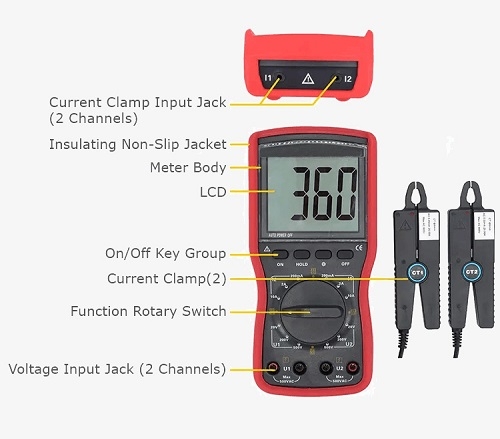A Volt-Amp Meter (VAM), often referred to as a Power Meter or VA Meter, is a measuring instrument used to monitor and display electrical parameters in an electrical circuit. It combines the measurement of both voltage (in volts) and current (in amperes) and provides information about power (in watts) and apparent power (in volt-amperes). Volt-amp meters are commonly used in electrical engineering and electronics to assess the electrical characteristics of a circuit or device. They are handy for understanding power consumption and evaluating the efficiency of electrical systems. This article will tell you how to use a volt amp meter.
Safety Precautions
Using a Volt Amp Meter (VAM) or a multi-function meter to measure voltage and current is a straightforward process, but it's essential to follow safety precautions and use the meter correctly.
- Ensure that you are familiar with the specific VAM's user manual and safety instructions before use.
- Always wear appropriate personal protective equipment, such as insulated gloves and safety glasses, when working with electrical circuits.
- Make sure the circuit or equipment you are testing is de-energized and turned off before making any connections.
- Verify that the VAM is functioning correctly and has been calibrated, if necessary, for accurate measurements.
- Be aware of the voltage and current ratings of the circuit you are testing, and select a VAM that can safely measure these values.
Steps to Use a Volt Amp Meter
- Set the Meter
Turn on the VAM and set it to the appropriate mode for your measurement. You typically have modes for voltage (V), current (A), and sometimes power (W) or other functions. Select the mode that matches what you want to measure. - Select the Range
If the VAM has multiple ranges, select the appropriate range for your measurements. For voltage, choose a range higher than the expected voltage, and for current, select a range higher than the expected current. - Connect the Test Leads
For Voltage Measurements: Connect the red (positive) test lead to the circuit's positive terminal or point and the black (negative) test lead to the negative terminal or point.
For Current Measurements: In series with the circuit, connect the VAM in the path of the current you want to measure. The red test lead is typically inserted into the terminal labeled "A" or "Current," and the black test lead is inserted into the common (COM) terminal.
- Take the Reading
For Voltage: Read the voltage value displayed on the meter's screen. Ensure you have the correct range selected, and note any units (e.g., volts, V).
For Current: Read the current value displayed on the meter's screen. Ensure the current is flowing through the VAM, and note any units (e.g., amperes, A). - Optional
If your VAM can measure power (watts), you can select the appropriate mode, connect the test leads accordingly, and read the power value. Power is calculated as the product of voltage and current (P = V x I). - Safety
After obtaining your measurements, turn off the VAM and disconnect it from the circuit. Always be cautious when working with live circuits, and ensure all safety precautions are followed. - Data Logging (if applicable)
Some VAMs have data logging capabilities. If you need to log measurements over time, set up the meter to record data at specific intervals. - Troubleshooting and Analysis
Use the measurements to troubleshoot problems, analyze circuit performance, or make necessary adjustments to electrical systems. - Record and Document
Keep a record of your measurements, as they may be necessary for documentation or analysis.
Working Principle
- Volt amp meters work on the principle of Ohm's law. According to Ohm's law, current is equal to the ratio of voltage to resistance, which is I=U/R. The volt-amp meter calculates resistance by measuring current and voltage.
- The volt amp meters has an internal current stop and a voltage stop. To measure current, select the appropriate range for the current setting of the volt-ohmmeter and connect the probe to a series resistor in the circuit. According to Ohm's law, the passage of current through the series resistance produces a corresponding voltage signal in the current position of the voltammeter. By measuring this voltage signal, the volt amp meters can tell the amount of current in the circuit.
- To measure voltage, select the appropriate range for the voltage setting of the volt-amp meter and connect the pens to the two points in the circuit where the voltage is to be measured. The formula according to Ohm's law is U=IR. the voltmeter can get the magnitude of the voltage in the circuit by measuring the voltage between the two points of the circuit.
If you need a volt amp meter, you can choose one at the sisco store. We offer 3-phase digital volt amp meters and digital volt amp meters can directly measure AC voltage (0~500V)etc.Volt-Amp Meters are indispensable tools in the field of electrical engineering and electronics. They provide accurate measurements, ensure safety, support energy efficiency, and contribute to the quality and reliability of electrical systems and devices.

